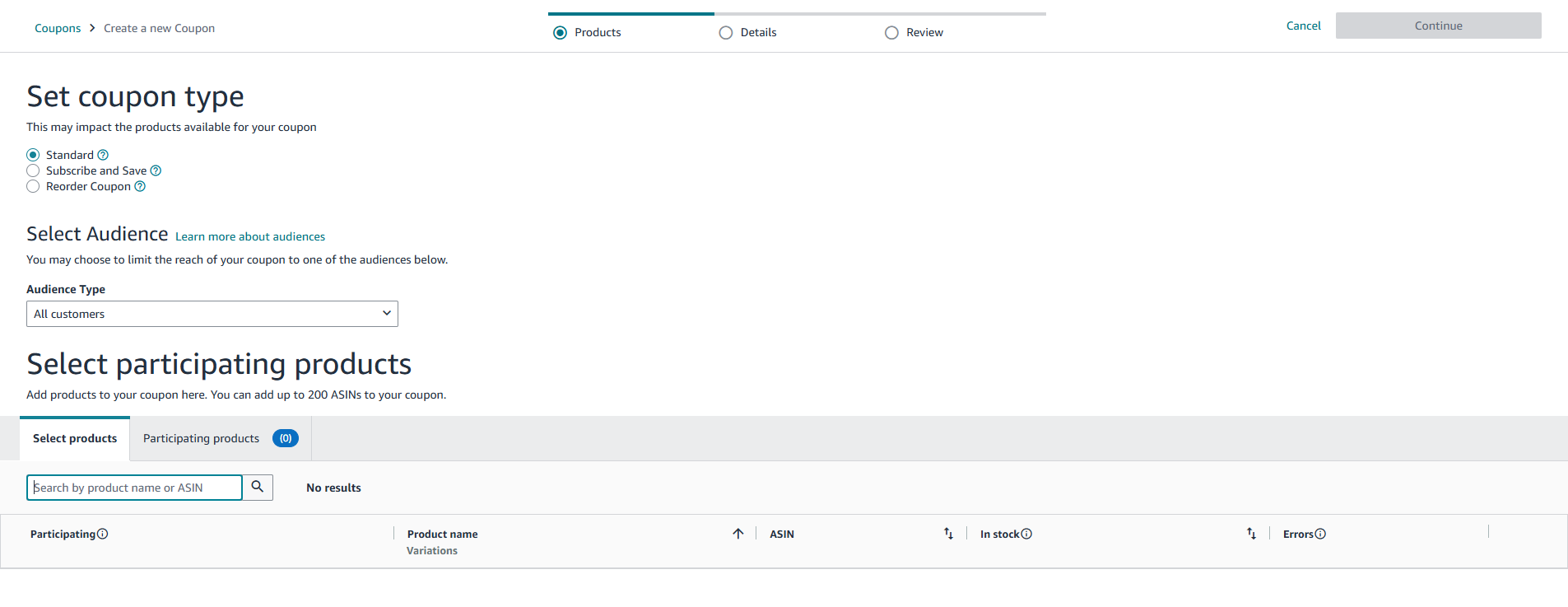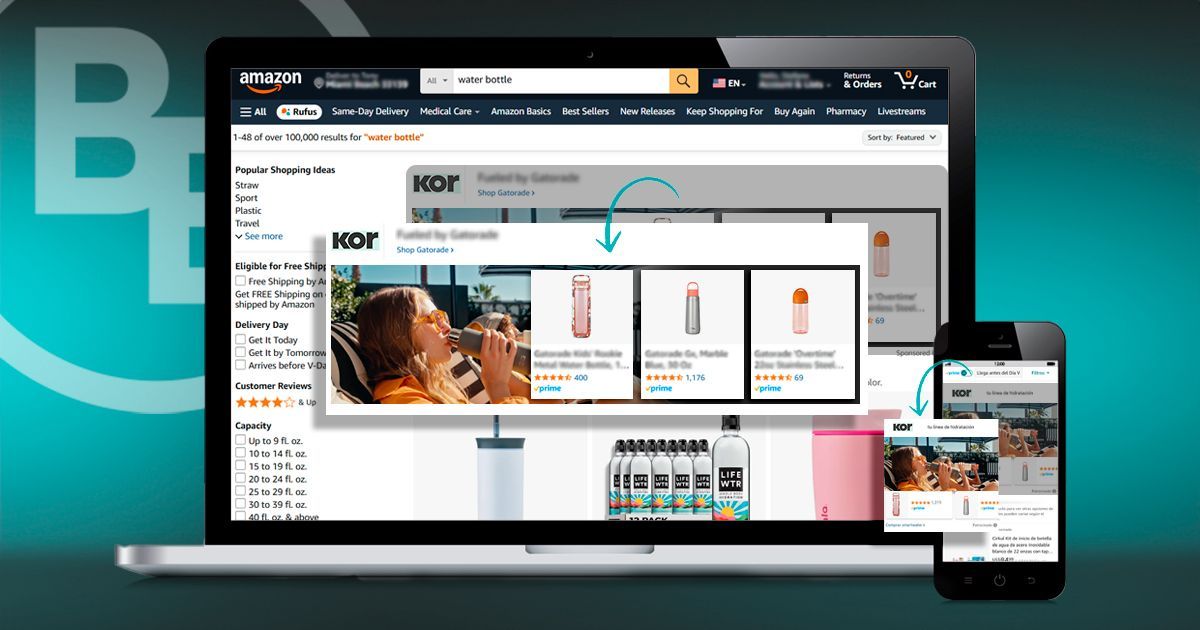By: Anthony Steele
Date Published: June 23, 2025
Read Time: 5 minutes

By: Anthony Steele
Date Published: June 23, 2025
Read Time: 5 minutes
Amazon offers a marketing program suite to help sellers attract attention, improve click-through rates (CTR), and increase conversion rates (CVR). Effectively leveraging these tools can give brands a competitive edge in the crowded e-commerce marketplace. Below, we explore key Amazon marketing programs, their features, and how they can drive business success.
Amazon Coupons are an obvious promotional tool, allowing sellers to offer discounts as a percentage off or a fixed amount. These coupons appear with green badging on product listings, making them stand out in search results.

Standard Coupons are the traditional discount offers you attach to your product listings. They are prominently displayed on your product pages and often appear in search results, making them highly visible to shoppers.
These eye-catching coupons help your product stand out in crowded search results or category listings.
Shoppers are more likely to try a product when they see an immediate discount, potentially turning interest into a sale.
Offering a standard coupon can entice new customers to take a chance on your product, leading to broader product trials.
They can be applied for limited-time offers, seasonal promotions, or to move excess inventory.
The Subscribe & Save program enables customers to set up recurring deliveries for essential items at discounted rates. Sellers may offer extra discounts, typically 5% or 10%, to encourage subscriptions. Designed for Amazon's subscription model, Subscribe & Save Coupons provide additional savings on top of the usual subscription discount, rewarding customers for committing to regular deliveries.
Incentivizing subscriptions helps create a dependable income stream, stabilizing revenue over time.
Subscribers often remain engaged with your brand longer, as the extra discount adds value to the subscription.
Regular orders reduce the need for constant customer acquisition, allowing for more efficient resource allocation.
Predictable subscription orders yield consistent sales data, aiding inventory planning and supply chain management.
Reorder Coupons target past customers, incentivizing them to make repeat purchases. These coupons are typically offered after purchase to reward loyalty and encourage customers to return.
By rewarding returning customers with discounts, you build long-term loyalty and improve lifetime value.
Reorder coupons act as a nudge for customers to buy again, especially when they’re already familiar with the product.
They reduce the need for heavy marketing spend on acquisition since the focus is on customers who already trust your brand.
Insights from repeat purchase behaviors can help you tailor future promotions and refine your overall marketing strategy.
Running promotions on Amazon isn't just about slashing prices; it's about strategically increasing your product's discoverability, urgency, and perceived value. Amazon offers multiple promotional tools that, when used effectively, can significantly boost your click-through rate (CTR) and conversion rate (CVR).
Lightning Deals
These time-sensitive offers featured on Amazon’s “Today’s Deals” page give products prime real estate and visibility.
Best Deals
Unlike Lightning Deals, Best Deals can run for up to two weeks, offering extended exposure.
Buy One Get One
(BOGO)
A classic upsell tactic that encourages shoppers to increase their order volume.
Conversion Hack: Promote the BOGO in your A+ Content or first bullet point to ensure it doesn’t go unnoticed.
Promotions aren’t just about discounts; they're high-impact visibility tools that can differentiate between a scroll past and a click. By aligning the right promo type with your product’s goals, you can drive sustained growth and build momentum on the marketplace.
Let’s be clear: Amazon is no longer a platform where great products sell themselves. It’s officially apay-to-play marketplace. Amazon generated over $56.2 billion in ad revenue in 2024 alone, which keeps growing. That means if you’re not investing in advertising, your competitors are, and they’re winning shelf space that could’ve been yours.
Whether you're a new seller launching your first product or an established brand looking to scale, Amazon Ads are non-negotiable for boosting visibility and driving traffic to your listings.
Amazon offers several ad types that serve different purposes throughout the buyer journey. Whether launching a new product or retargeting past visitors, using the proper format and boosting it with strategic tools like coupons can significantly improve your return on ad spend (ROAS).
Sponsored Products ads appear in Amazon’s search results and product detail pages. They are performance-focused and highly measurable, and remain the most reliable starting point for sellers aiming to drive direct conversions.
Strategy Tip: If you are new to Amazon Ads, start with Sponsored Products. They typically yield the most predictable and measurable returns compared to other ad types.
Pro Optimization: Pair your Sponsored Products ads with Coupons. When a product has an active coupon, the green “Save X%” badge appears inside the ad. This instantly makes the ad more attractive, increases click-through rates (CTR), and drives stronger conversion rates.
Amazon’s system automatically matches your product to customer search terms and product pages.
| Pros | Cons |
|---|---|
| Fast setup, no keyword research needed | Limited control over targeting |
| Good for keyword discovery | May waste be spent on irrelevant traffic |
| Helps find ASINs for future targeting | Lower efficiency if not optimized early |
Best Use Cases:
| Pros | Cons |
|---|---|
| Full control over targeting and bidding | Requires keyword research and setup |
| Higher efficiency and better ACoS | Needs frequent optimization and updates |
| Ability to scale winners more precisely | Potential to miss new keyword trends |
Best Use Cases:
Pro Tip: Layer Auto + Manual for Best Results
Use Auto campaigns to harvest keywords and ASINs, then transfer top performers into Manual campaigns for precision scaling.
Example Strategy:
Sponsored Products are your entry point for profitable advertising on Amazon. By understanding the trade-offs between Auto and Manual campaigns and layering them together, you can create a sustainable, data-driven ad strategy that fuels visibility, sales velocity, and long-term growth.

Strategy Tip: Use keyword targeting to dominate branded searches. Bidding on your brand terms protects visibility and deters competitors from stealing traffic.
Pro Optimization: Use Sponsored Brands + Coupons during seasonal events (like Prime Day or BFCM) to drive clicks across your product line. Highlight promotional pricing in your creative assets.
Sponsored Display is one of Amazon’s most versatile ad types because it allows you to reach shoppers on and off Amazon with highly targeted messaging. Unlike Sponsored Products or Brands, Sponsored Display gives you control over audience targeting, not just keyword or ASIN targeting.
Best for:
| Audience Type | What It Targets | Why It Matters |
|---|---|---|
| Views Remarketing | Shoppers who viewed your product detail pages | Great for retargeting warm audiences who showed high intent |
| Purchases Remarketing | Shoppers who previously purchased your products or similar ones | Perfect for upselling, cross-selling, or replenishment marketing |
| Searches/Interests-Based Audiences | Shoppers who searched for or showed interest in related categories | Expands reach to new but relevant audiences |
| Product Targeting | Competitor products or associated products directly | Let's you appear on competitor detail pages to steal share |
Strategic Tips
Pro Optimization Tip
If you have an active coupon or deal, it will automatically show on your Sponsored Display ads.
Sponsored Display is not just about retargeting; it’s a full-funnel driver that helps you reconnect, cross-sell, and expand to new audiences. By carefully choosing your audience type and layering in promotions like coupons, you can unlock powerful growth opportunities on and off Amazon.
Pro Tip: If you're using DSP or brand campaigns, AMC can help you make more data-driven cross-channel decisions.
There’s no one-size-fits-all answer, but here’s a solid starting point:
Think of TACoS as the broader measure. If you’re investing more upfront, ensure your ads support long-term organic growth.
Also, monitor ACoS (Advertising Cost of Sale) per campaign to ensure each ad group is profitable. Targeting branded terms typically drives down ACoS, while competitive conquesting may raise it.
Amazon advertising is no longer optional; it’s the engine driving discoverability on the platform. By combining the right ad types with sharp targeting and analytics, Bridges can unlock consistent, scalable growth.
If you’re not yet investing in Amazon Ads or not optimizing your spending, you’re missing out on one of the most powerful levers for accelerating sales and building a defensible brand presence.
In a sea of similar products, what makes yours stand out? The answer is Enhanced Brand Content. Amazon’s A+ and Premium A+ (A++) Content lets you go beyond plain-text descriptions and turn your product detail page into a visual storytelling tool with measurable impact.
Amazon’s standard A+ Content allows Brand Registered sellers to add:
Why it matters:
According to Amazon, A+ Content can increase conversion rates by
up to 10%,
often higher in competitive categories where customers need more context before buying.
For brands approved for Premium A+ (typically high-performing or 1P vendors), this upgraded version includes:
The impact? According to Amazon's internal benchmarks, Premium A+ can boost conversion rates by up to 20%.
Strategy Tip:
Use Premium A+ to
overcome objections visually. For example, show how your supplement dissolves better or how your rug resists stains in a real-life kitchen.
Over 70% of Amazon purchases now happen on mobile, yet many sellers still design content with a desktop-first approach. On mobile:
Strategy Tip: View your A+ layout in both formats via the “Manage Your Experiments” or Seller Central preview tools. What looks sleek on the desktop can feel clunky on mobile if not optimized.
Above the A+ Content sits the often-underused Brand Story section, a key area to reinforce brand authority. Use it to:
Pro Tip: Amazon recently expanded this section’s real estate on mobile, making it more noticeable than ever.
Amazon’s Listing Quality Dashboard flags opportunities to improve content, including missing A+ or low-quality assets. Optimizing your listings here:
Since A+ content (especially with video) reduces bounce rate and increases dwell time, it sends positive engagement signals to Amazon’s algorithm, helping your listing show up more often in organic and ad placements.
Enhanced Content isn’t just about looking good; it’s a revenue-driving asset that separates strong brands from forgettable ones. By combining visually compelling A+ (or Premium A+) content with optimized mobile layouts and a compelling brand story, you not only increase conversions but also strengthen your position in Amazon’s algorithmic eyes.
This is a non-negotiable strategy for boosting CVR, customer trust, and long-term brand equity on Amazon.
On Amazon, pricing is more than a number; it’s a signal. It impacts your visibility, Buy Box eligibility, conversion rate, and, ultimately, your long-term success. With millions of shoppers comparing similar products, your pricing strategy can elevate or bury your brand.
Amazon’s algorithm evaluates price as a core signal when surfacing products. A price that is too high can cause visibility and Buy Box share to be lost, while a low price can erode margins and brand perception.
Stat Check: Over 80% of Amazon sales go through the Buy Box, and pricing is a critical factor in winning it, especially for 3P sellers competing with others on the same ASIN.
Monitor Competitor Pricing Frequently
Keep an eye on both direct and indirect competitors. Regular audits help you avoid being undercut or misaligned in your category.
Use Dynamic Pricing to Stay Agile
Dynamic pricing adjusts your product price based on rules you set, such as undercutting a competitor by $0.05 or staying within a margin threshold.
Use Promotions Without Cannibalizing Margins
Instead of racing to the bottom, blend strategic discounting, such as
Coupons,
Limited-Time Deals, or
BOGOs, to create urgency and value perception without slashing the base price.
Amazon considers these pricing-related signals when awarding the Buy Box:
Heads Up: If your product is priced significantly higher than the competition or lower than your price on other platforms, Amazon may suppress your Buy Box or mark your offer as “Not Competitive” in the Listing Quality Dashboard.
The key to pricing on Amazon is intelligent responsiveness, not a race to zero. Whether using Amazon’s Automate Pricing tool or a 3rd-party repricer, combining real-time data with strategic discounting ensures you stay competitive without sacrificing your margins or your brand’s perceived value.

Amazon’s marketing tool suite, which includes promotions, premium content, and ad placements, isn’t just isolated tactics. When used strategically, they work together to attract high-intent shoppers, earn the click, and convert that interest into long-term customer value.
Here’s how the top-performing brands leverage these tools:
First impressions matter. Amazon listings enhanced with
Coupons,
Lightning Deals, or
green promo badging stand out in a sea of competitors. These elements visually signal value, making browsers stop scrolling.
Click-through rates (CTR) spike when listings combine strong visual assets with innovative pricing strategies:
Pro Tip: Pair compelling pricing with A/B-tested main images to find the best-performing combination for each product.
Once shoppers click,
conversion rate (CVR) hinges on how well your listing builds trust and addresses objections:
Listing Quality Dashboard: Ensuring your listing is fully optimized (from A+ to reviews to inventory health) increases your chances of surfacing in search and winning the Buy Box.
The most successful brands combine these programs with a backend strategy:
Experimentation (via Manage Your Experiments) ensures you always refine what works.

No single tool drives Amazon's success; the orchestration of ads, content, pricing, and loyalty programs, backed by data, builds profitable momentum.
The most innovative brands don’t just run promotions or ads. They test, track, and align every lever from content and pricing to targeting to grow their footprint and maximize returns at every stage of the funnel.
(754) 273-7016 | 1680 Michigan Ave Suite 700 #215 Miami Beach, FL 33139